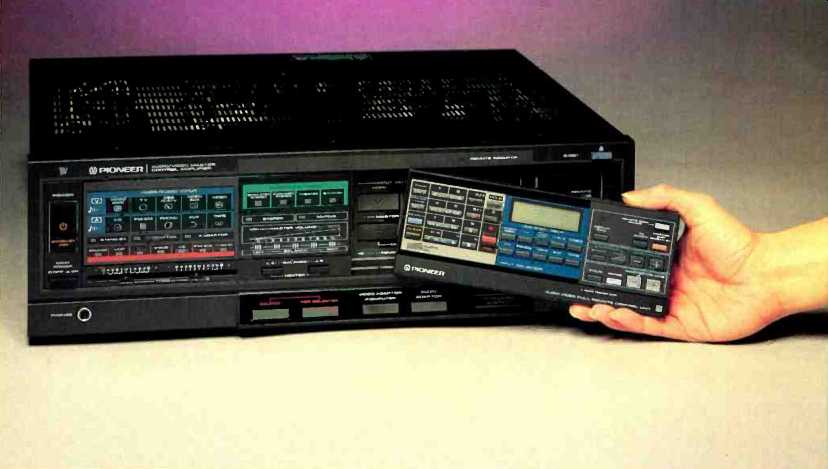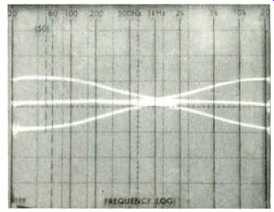
Manufacturer's Specifications:
Power Output: Stereo mode, 50 watts per channel into 8-ohm loads, 20 Hz to 20 kHz; surround mode, 25 watts per channel into 8-ohm loads, 20 Hz to 20 kHz (front channels), 100 Hz to 4 kHz (rear channels).
THD: Stereo mode, 0.09%; surround mode, 0.09% (front), 1.0% (rear).
Frequency Response: Phono, RIAA ±0.5 dB; high level, 20 Hz to 50 kHz, +0,-2.0 dB. Audio Input Sensitivity: Phono, 2.5 mV; high level, 150 mV.
S/N Ratio: Phono, 73 dB; high level, 91 dB.
Tone-Control Range: Bass, ± 10 dB at 100 Hz; treble, ± 10 dB at 10 kHz.
Power Requirements: 120 V, 60 Hz, 180 watts.
Dimensions: 16 9/16 in. W x 51/8 in. H x 15 5/16 in. D (42.1 cm x 13 cm x 39 cm).
Weight: 24 lbs., 4 oz. (11 kg).
Price: Approximately $485.
Company Address: P.O. Box 1540, Long Beach, Cal. 90801.
The SA-V70 audio/video control amplifier is, as its name implies, one of the growing number of audio components designed for use in A/V systems. The system in question is Pioneer's Foresight 77, which also includes either a 26-inch color monitor or a 40-inch projection TV, a combination CD and LaserVision videodisc player, a pair of three-way loudspeakers, and an AM/FM tuner, plus furniture to hold it all. System options include an 8-mm VCR that can also record digital audio, a linear-tracking turntable, rear speakers for surround sound, and an auto-reverse dual-cassette deck. The SA-V70 is designed to serve as the control center for all these, and therefore incorporates remote system control, inputs and outputs for video as well as audio, and surround sound.
My main purpose in testing this key audio element of the system was to determine if its quality was as high as that of Pioneer's separate audio components. After extensive lab and listening tests, I concluded that this amplifier certainly qualifies as a high-fidelity audio component, even if its measured performance is not quite up to the level of the current crop of mid-priced separate amplifiers. You'll see what I mean when the test results are presented.
Features and Layout
As its specifications show, the SA-V70's power can be divided in two ways. As a stereo amplifier, it delivers 50 watts per channel to a pair of stereo speakers. For surround-sound use, it divides its power into four channels of 25 watts each.
The remote-control unit for the entire AN system is a detachable section of the amplifier's front panel; removing the remote exposes other controls of the amplifier. The remote has 37 buttons (some of them multi-purpose), and a display that shows the function selected. Once you use the remote unit to select any of the amplifier's 10 audio and audio/video inputs, the remote then switches button-control function to the appropriate component.
The amplifier control section of the remote selects surround mode; turns surround sound on and off and adjusts its volume; adjusts overall volume; turns muting on and off; selects stereo, left-only, or right-only sound (since many video sources are still mono), and turns the amplifier on and off. Another button switches the video monitor on and off.
A useful "Hold" function on the remote unit allows you to watch or listen to one Foresight component while operating a different one at the same time. For example, you could watch a TV program picked up by the monitor receiver while setting the system's VCR to record another program via its own tuner.
The controls revealed when the remote module is removed from the amplifier's front panel include touch switches ("Audio" and "Video") that advance the unit through the various input selection options, one by one, and touch switches for "Master Volume" ("-" and "+"). Controls along the lower edge of the panel, visible even when the remote is in place, include "Source" and "Rec Selector," a "Video Adaptor/Computer" switch (which allows you to connect an accessory device in series with the video signal path), and an "Audio Adaptor" switch which does the same thing for audio accessories (equalizer, time-delay unit, etc.). A stereo phone jack is at the extreme lower left of the front panel.
The upper left half of the front panel contains a series of 10 audio and video input function indicators, and additional indicators for record selection. Other lights show surround sound, stereo, and muting status; a sliding scale illuminates to show volume level. Touch switches adjust channel balance, and a pair of slider controls are used to manually adjust bass and treble. A "Main Power" switch and a "Power Stand-By/On" switch are at the left end of the panel. "Main Power" must be turned on in order for the remote unit to control power to the amplifier or the other components connected to the amplifier's rear-panel a.c. receptacles.
I counted no fewer than 39 phono jacks on the rear panel of this master unit, for the many audio and video inputs and outputs that can be connected. In addition to these familiar jacks, there are also special receptacles for remote-control input and output cables, which interconnect with other components of the system. A mode switch chooses stereo or surround-sound (four-channel) operation. Speaker terminals are arranged so that either two or four speakers can be connected. Since video signals pass through this amplifier, an r.f. modulator is built in, with a selector switch for choosing either channel 3 or 4 on the rear panel. Six a.c. receptacles complete the rear-panel layout. Five of them are switched, while the sixth is an unswitched outlet intended for a VCR. This arrangement prevents the VCR's power from being switched off by the SA-V70 or its remote, thereby allowing the VCR to be switched on and off by its built-in clock/timer.
Measurements
The SA-V70's power amplifier section delivered 55.6 watts of power per channel for a 1-kHz input signal into 8 ohm loads for its rated harmonic distortion level of 0.09%. Even at the frequency extremes of 20 Hz and 20 kHz, power output remained at a 54-watt level for the same rated THD. Yet, dynamic headroom was very low, only 0.42 dB, indicating that when receiving music signals, the amplifier will not deliver much more power than it can when the input signal is a continuous test tone. Fortunately, the loudspeakers supplied with Pioneer's Foresight system are fairly efficient (90 dB/watt/meter), so they will probably deliver adequate acoustic power when driven by the SA-V70. Damping factor measured an adequate, if not spectacular, 42. Twin-tone IM (CCIF IM) was a very low 0.012%, and SMPTE IM at rated output measured 0.05%.

Fig. 1--Tone-control characteristics. Vertical sensitivity: 10 dB/div.
The preamplifier section measured very well on the test bench, with one or two exceptions. Overall frequency response for the high-level inputs was flat within 1 dB from 8 Hz to 30 kHz. The -3 dB cutoff points were at 4.5 Hz and 60 kHz. Signal-to-noise ratio for the high-level inputs measured a very excellent 89 dB, while in phono mode the S/N was an equally outstanding 78 dB. These numbers compare favorably with the kind of performance you expect from a separately sold integrated amplifier. Phono overload, however, was only 65 mV; I consider 100 mV at 1 kHz to be the minimum that a phono input stage should be able to handle, what with the wide dynamic range of today's LPs. (One probably ought to substitute a relatively low-output phono cartridge for the high-output model supplied in Pioneer's optional turntable.) The SA-V70's phono frequency response, on the other hand, was excellent, deviating from the standard RIAA curve by no more than 0.2 dB at any point from 30 Hz to 20 kHz.
Action of the bass and treble controls is shown in the 'scope photo of Fig. 1. As you can see, these tone controls are rather rudimentary, in that they use the same center frequency pivot point. This makes them relatively useless when you're trying to peak or attenuate frequency extremes (either at the bass or treble end of the spectrum) without affecting mid-frequencies.
Use and Listening Tests
In order to appreciate the SA-V70, you really have to use it with the total audio/video system of which it is a part. I did just that, since Pioneer was kind enough to supply not only the basic elements of the system, but the optional cassette deck, turntable, and TV monitor; the pair of cabinets which house all of these components, and, perhaps best of all, a pair of optional, smaller speakers which enabled me to check out the surround-sound operation of the system.
As you may know, many movie videocassettes are recorded with matrix-encoded sound channels which, when reproduced through an appropriate four-channel audio amplifier/matrix decoder, can rival the spectacular surround sound you hear in suitably equipped theaters. Most films produced with Dolby Stereo, for example, exhibit this effect when properly played back. The surround-sound processor built into the SA-V70 has four modes: "Simulated Stereo" (for use with mono signals), "Expanded Stereo" (for mono signals, or to enhance stereo), and "Theater" and "Stadium" surround modes. These last two modes, which were not designed specifically for Dolby Surround software, require setting the amplifier to its "Surround" (four-channel) mode and hooking up four speakers. The extra pair of speakers can be positioned at the sides of the room, to the right arid left of the front speakers, or at the rear of the room. I preferred them behind me, at the rear, and found that I got the most dramatic effect that way. Both the "Simulated" and "Expanded" stereo settings were quite effective with mono signals, particularly the latter, which seemed to add an extra dimension and breadth to reproduced stereo music without spoiling the intended sound image.
As far as the total system is concerned, I was impressed by the simplicity of interconnection. The control links between the SA-V70 and other Foresight system components form a "daisy chain" buss from one component to another, instead of a mess of cables running between each component and the amplifier. I also liked the metallic charcoal-gray finish of the components, which blends nicely with the rosewood of the two equipment cabinets.
For a newcomer to components who wants a total system without the hassle of mixing and matching (or the chance of mismatching), a total audio/video system such as Pioneer's Foresight 77 makes sense. In that context, the price/performance ratio of the SA-V70 master amplifier is very reasonable. If, on the other hand, you are a seasoned audiophile who wants to get involved with video, the "separates" route may still be best for you-providing your pocketbook can support your audio and video taste.
-Leonard Feldman
=================
(Audio magazine, Jan. 1987)
Also see:
Pioneer Model TX-9100 AM/FM Stereo Tuner (Equip. Profile, Aug. 1973)
Pioneer F-90 Tuner (Jan. 1984)
Pioneer TX-9500-II AM/FM Stereo Tuner (May 1977)
Pioneer Model TVX-9500 TV Audio Tuner (Equip. Profile, Nov. 1978)
Pioneer TX-9800 AM/FM Stereo Tuner (Equip. Profile, Nov. 1979)
= = = =